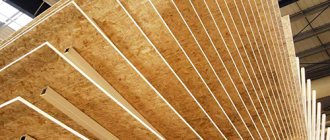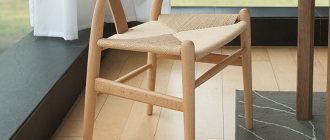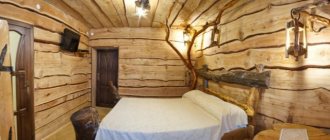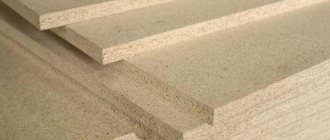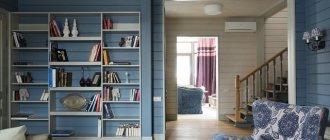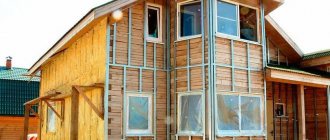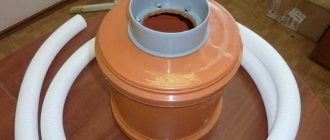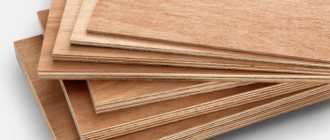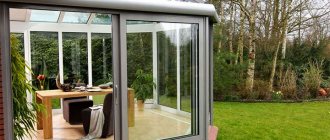Natural wood is an environmentally friendly, safe material that has the power of living nature. That is why solid wood furniture is highly valued all over the world. Wooden decor can be perfectly combined with various materials and is appropriate in any interior.
The surface of the tree where it was cut has a unique pattern: rings, stripes, rays, waves. They often try to “imitate” this unique pattern on other, cheaper materials. But painting and excessive processing of natural wood, on the contrary, destroy its individuality, unify it and create a certain standard that is incomparable with the character that this noble material has.
What textures and designs did nature itself give us?
Wood and natural stone
The combination of wood and stone is quite popular in turnkey design projects. And this is not surprising, since these two materials look great together. They are both natural and natural, which is also important. When combining these materials, it is important to take into account one feature: if the wood has a textured surface, then it is better to make the stone smooth, and vice versa.
Photo: thespruce.com
Visible defects in lumber
Defects are defects in individual sections of wood that contribute to a decrease in its quality and limit the possibility of use. Often formed during plant growth, and only a small amount during storage and use of lumber. The degree of influence of a defect on the quality of wood material is determined by its type and location, the dimensions of the defect, and the purpose of the future lumber.
The main defects include:
- knots;
- cracks;
- trunk shape defect;
- chemical color;
- biological defects - fungi;
- damage by insects and rodents;
- mechanical defects;
- warping.
Wood and smooth surface
Calculate the exact cost of repairs using an online calculator
and receive a free detailed estimate for repairs
Calculate
The combination of smooth surfaces and wood looks great in modern interiors. It is often implemented in furniture or wall coverings, when the wood texture is complemented by a glossy surface. For example, a wall trimmed with wood in the bathroom harmonizes perfectly with the glossy surfaces inherent in the bathroom.
Photo: trendir.com
Types of wood
When choosing the type of wood for a particular job, the main parameters are the density and texture of the wood, as well as the desired color. At the same time, the natural shade of wood depends on the place where the tree grows; for example, the color of boxwood grown in the Krasnodar Territory can be radically different from the color of boxwood grown in the Caucasus.
Let's look at the trees I work with most often.
BOXWOOD
Boxwood wood is one of the hardest among European tree species. Valuable boxwood has been cut down for centuries without thinking about the consequences, and today this material is very rare. In the old days, seals were cut from boxwood, which once again confirms its amazing characteristics.
Average density: 1050 kg/m3
Color: Natural wood color is light yellow. Due to its high density, boxwood does not absorb stains well, so the color can be changed from natural to black by cooking the product in oil.
Advantages: The density of boxwood and its uniformity allow you to cut out small parts without loss of quality. Does not form “lint” when carving.
Disadvantages: Not identified in the wood characteristics. The only drawback is the difficulty of acquiring high-quality blanks and the higher cost compared to domestic breeds.
Natural color samshia cross
A boxwood cross boiled in oil to obtain a darker shade.
SANDALWOOD
Sandalwood is considered one of the most valuable species in the world. Sandalwood oil is extracted from this wood. Both the wood and the oil have a characteristic aroma that has been highly prized for centuries. Unlike many other aromatic species, it retains its scent for many decades.
Average density: 900 kg/m3.
Color: Natural brown sandalwood color. The color can be changed from natural to dark brown by cooking the product in oil.
Advantages: The density of wood is slightly inferior to boxwood and is high. Thanks to the oils contained in the tree, products made from sandalwood have a pleasant aroma, especially when heated.
Disadvantages: excessive interweaving of fibers due to which “lint” may form when carving.
On the right is a cross made of sandalwood in a natural color, on the left is the same model boiled in oil. Both crosses are made from the same block.
Cross made of sandalwood in natural color. A block from a different batch.
PEAR
Pear wood differs positively from other domestic tree species in its hardness, strength and wear resistance.
Average density: 730 kg/m3.
Color: The color of the wood depends on the age and place of growth, ranging from light tones to dark brown (red). The color can be changed by cooking in oil or opening with stains and oils.
Advantages: Availability of blanks, inexpensive.
Pear wood has a smooth, soft, not rich texture, which is a big advantage in carving small plastics. Due to the uniformity of the texture, the pear can be cut both lengthwise and crosswise. It is easy to polish and accepts processing agents (stains, oils, varnishes) well.
Disadvantages: Requires more careful care (impregnation with oil) when wearing the product in a humid environment.
Pear icon made of natural color
BEECH
Beech wood has always been valued by furniture makers for its rich texture and good workability. Beech is also widely used in construction, because materials made from it are wear-resistant.
Average density: 670 kg/m3.
Color: Beech wood is white with a yellowish or reddish tint, with pronounced dark veins. The color can be changed by cooking in oil or opening with stains and oils.
Advantages: Availability of blanks, inexpensive.
Disadvantages: The texture of beech clogs the relief and to make it more readable it is necessary to boil the product in oil to even out the tone of the rock, which in turn changes color.
Beech cross lightly boiled in oil.
A beech cross boiled in oil until black.
EBEN
Due to its high price, this type of wood has never been widely consumed. In ancient times, it was valued on a par with gold. Ebony furniture has been valued since the times of the Egyptian pharaohs. The most sought-after properties are the ability to obtain a perfectly smooth surface after polishing. Ebony visually resembles metal, which is complemented by a noticeable coldness upon contact with its surface. It is a heavy wood that sinks in water.
Average density: 1150 kg/m3.
Black color
Advantages: The texture of ebony is so uniform that even upon close examination it is impossible to see the annual rings or fibers. Does not form “lint” when carving.
Disadvantages: High cost of bars. Also, the disadvantage of Eben is its fragility, so when wearing the product it is necessary to prevent it from falling, otherwise chips are possible.
Ebony cross
HORNBEAM
Hornbeam is a worthy representative of domestic species. Hornbeam wood has high strength and is resistant to impacts and mechanical damage. Hornbeam is widely used in various fields of construction, furniture making, mosaics and wooden jewelry.
Average density: 800 kg/m3.
Color: Light, uniform. Due to its high density, it does not absorb stains well, so the color can be changed from natural to black by cooking the product in oil.
Advantages: The texture of hornbeam wood is practically not expressed, even the annual rings are very difficult to distinguish.
Disadvantages: In natural color, the relief of the finished product is difficult to read, and therefore requires cooking in oil or impregnation with stains to change the color.
Khachkar. Armenian cross made of hornbeam.
MONZO
Monzo is a valuable species and is particularly durable, which is why it got its name “lead tree”. The density of the wood is so high that even railway sleepers were previously made from it. It is a heavy wood that sinks in water.
Average density: 1250 kg/m3.
color . To change color, cooking in oil and opening with stains is not required; simply opening the product with oil is enough.
Advantages: Extraordinarily beautiful texture, which, unlike other breeds, does not clog the relief of the product. Does not form “lint” when carving. The density of monzo allows you to cut out small details without loss of quality.
Disadvantages: Fragility, so when wearing the product it is necessary to prevent it from falling, otherwise chips are possible
Monzo cross.
Of course, during all my time working with wood, I have carved products from other types of wood, but the ones listed, in my experience, are the most suitable for making carved crosses, icons and bracelets.
I hope this article will help you decide on the desired material, and if not, I will always be happy to answer your questions and suggest which breed is best.
Thank you for your attention! All the best!
Relief and smooth surfaces
The combination of embossed and smooth surfaces is used by designers to ensure that plain interior items do not merge. This solution is well suited for decorating walls; for example, smooth white surfaces can be diversified with 3D panels. But it is not necessary to use texture only with plain walls - colored ones, in turn, will add contrast and make the room more elegant.
Photo: moonwallstickers.com
Assortment
Lumber for construction purposes is produced mainly from coniferous trees - pine, fir, spruce, larch and cedar. GOST 24454-80 regulates the standards for the size of finished products that lumber must comply with (assortment) and the division of products by functional purpose (assortment).
All wood materials are described in accordance with geometric parameters. Standard nominal values are indicated in a special table. The standard is not extended to valuable tree species. It is allowed to create products according to individual requests.
Description of lumber assortment:
- board (edged and unedged);
- croaker;
- beam;
- plates;
- quarters;
- logs
Assortment
Tree and living plants
In modern interiors, a combination of wood and living plants is often used. This combination gives the interior life, adds bright colors and freshness. Plants are often sold in the form of a phytowall, and wood serves as a facing material for it.
Photo: possibledecor.com
Properties of rare trees
The trees in question grow within our country. Huge forest spaces make it possible to obtain timber with the necessary characteristics.
However, craftsmen use material brought from abroad. Imported timber has other properties and is used to make furniture and decorations.
Wood imported to Russia:
- Red tree;
- Ebony;
- Eucalyptus;
- Fernambuc;
- Rosewood;
- Satin tree.
The wood of these trees allows you to create unique things.
